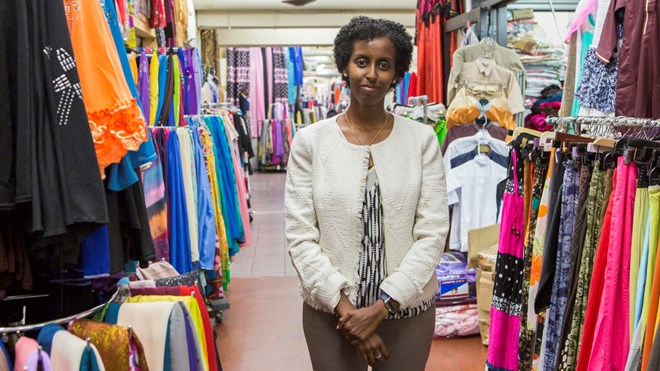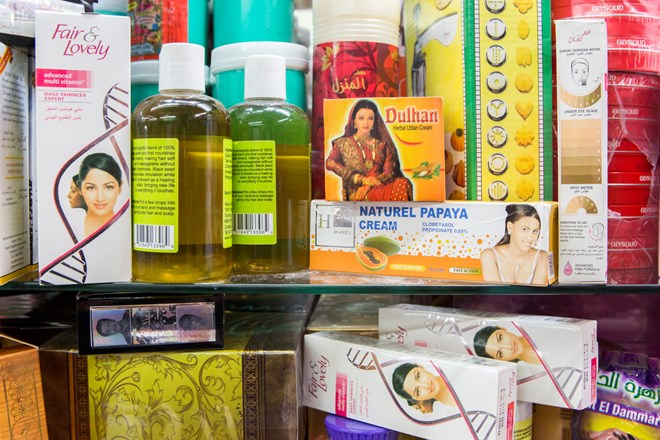STAT News
Tuesday January 16, 2018
By Sheila Mulrooney Eldred / Photos by Sarah Stacke for STAT
 Amira Adawe inside Karmel Square, unofficially known as the Somali Mall, in Minneapolis.
Amira Adawe inside Karmel Square, unofficially known as the Somali Mall, in Minneapolis.
MINNEAPOLIS — Karmel Square is a hub of the Somali community here, a colorful, cheerfully noisy hodgepodge of vendors and restaurants unofficially known as the Somali Mall. Amira Adawe stops by often to buy tea and chat in Somali with friends and relatives wearing hijabs and flowing, floor-length skirts. They greet her with smiles and hugs, and she calls them “auntie.”
Her visits are more than social, however. The public health advocate scans market shelves for skin lightening creams that may contain harmful toxins — tubes and jars sold under names such as Fair & Lovely, Prime White, and Miss Beauty 7 Days White.
Some women use the creams in hopes of erasing dark spots, but many rub them over their entire bodies multiple times a day in hopes of whitening their brown skin. The practice pervades many cultures in Africa, Asia, the Middle East — and many immigrant communities in the U.S. — and Adawe has made it her mission to end it.
She began her crusade as a graduate student, after she discovered that creams sold in many Twin Cities ethnic markets contained levels of mercury thousands of times higher than the amounts considered safe by the U.S. government. But her concerns go beyond the physical harm to women. She worries as much about the damage to their self-esteem.
newsnisideIn Somali and other cultures, the lighter-skinned daughter is often seen as more beautiful, Adawe explained recently; in fact, the Somali term for light-skinned — cadey — is considered a compliment. “It’s used as a term of endearment,” she said, “but I think it’s so wrong to say it.”
Public health agencies in several major cities have launched their own investigations of tainted skin creams, occasionally getting advice from Adawe along the way. And now Adawe has created The Beautywell Project, to combat the stigma faced by women with darker skin and take on the industry that promises them beauty in a jar.
By day, Adawe is now a manager for the Children’s Cabinet of Minnesota Gov. Mark Dayton. In her “spare time,” she hosts a weekly radio show in Somali that reaches 80,000 people worldwide. She holds educational outreach sessions in Minneapolis and Kenya, talks with imams, and presents at national and international conferences. Sooner or later, most anyone connected with the skin-lightening issue seeks out Adawe. She fields personal pleas for help from Somali men in Minneapolis worried about their pregnant wives rubbing cream on their skin, as well as calls for help from Kenya, Canada, and Australia.
“We can’t address this issue without discussing beauty, what it means and ways to redefine beauty, as well as discussing and educating individuals about wellness,” she said in an interview.
She admits her goal is ambitious. The stigma runs deep, and skin-lightening creams are a multibillion-dollar business overseas, despite bans and public campaigns against the products in many African countries. In the U.S., creams are often smuggled in and sold in small, ethnic markets like at Karmel Square or purchased on the internet. They have been found in Somali, Hmong, Mexican, Dominican, and West Indies communities from California to Minnesota to New York. Users, and even sellers of the creams, are often unaware that they are harmful or illegal.
Somali women are reluctant to speak openly about skin lightening, and Adawe faced resistance when she began her research seven years ago. Her persistence impressed Jim Koppel, who was deputy commissioner of the Minnesota Department of Public Health at the time.
“It’s a very tight-knit community, and this put her in a tough place,” he said. “It could have had a negative impact on the businesses [that sell the creams], both financially and potentially for legal problems, and was of great concern to her personal reputation. And she went ahead and did it and continues to speak out.”
“I had to be brave enough, and, fortunately, the community saw it as an issue” and supported her, Adawe said. “That means a lot to me.”
A topic few wanted to talk about
One recent afternoon, Adawe was 35 minutes into her radio show, broadcast from the studio of KALY, 101.7 FM, a Somali-American station tucked into a corner of the International Bazaar in Minneapolis. She had been talking nonstop about skin lightening, peppering her fluent Somali with a few English words — endocrine system, mercury, hydroquinone, prescription.
Then she turned to the phones, murmuring in understanding as she listened to a female caller from a Minneapolis suburb. Do you have any more feedback, Adawe asked in Somali.
 Skin whitening creams displayed for sale at Karmel Square.
Skin whitening creams displayed for sale at Karmel Square.
“Women who practice skin lightening and who have experienced skin damage or illness should come to the radio and discuss their experience without disclosing their names,” the caller said in Somali.
Adawe nodded. The topic of skin lightening is a delicate one, both overseas and in immigrant communities in the U.S. While the stigma associated with dark skin is deep, admitting to using skin-lightening creams is also taboo, thwarting efforts to track the prevalence of the practice. As adept as Adawe is at navigating the delicate social norms and customs of the Somali-American community she’s part of, when she began her research in 2011, she could find only seven women who would talk about their use of skin creams.
It was in those interviews that women told her that they apply the creams to their entire bodies three times a day, sometimes while pregnant or breastfeeding. Most mixed several creams together and stored them in the refrigerator.
Adawe had been suspicious of the creams since her childhood. Growing up in Mogadishu and Minneapolis in a health-minded family (her mother was the head of the maternal and child health bureau in Somalia), she watched with concern when friends’ and relatives’ skin reddened or grew discolored from using skin lighteners. Adawe is grateful for the message she received growing up with the darkest skin of three daughters: “I’m so fortunate I came from a family who embraced me for who I am,” she said.
When Adawe became a county public health educator and a graduate student at the University of Minnesota School of Public Health, she was finally in a position to act on her concerns. She purchased 27 samples of creams to test for the toxins she suspected were present.
The tests confirmed Adawe’s fears, revealing that 11 of the products contained mercury, a known neurotoxin. Mercury has been banned in skin-lightening products by the Food and Drug Administration since 1973; the legal limit is 1 part per million. Adawe still remembers the shock she and the pollution control agency specialists who did the testing felt when they saw the results reaching 33,000 parts per million.
FDA spokeswoman Lauren Sucher said mercury is on a short list of prohibited ingredients in cosmetics. “The FDA has been aware of mercury as a potential allergen, skin irritant and neurotoxin for decades,” she said in an email.
Poisonous to the nervous, digestive, and immune systems, it is often found in unlabeled or mislabeled creams; sometimes it’s listed as “mercurous chloride,” “calomel,” “mercuric,” or “mercurio.” Just touching a washcloth or a mother’s cheek that has been rubbed with the products could be harmful to a baby, the FDA notes, interfering with brain and nervous system development.
Yet the agency was able to inspect only 0.3 percent of 3 million cosmetics shipments last year, and it tested just 364 products even though “adverse findings” are discovered in 15 percent to 20 percent of the products tested, the FDA said last June in a letter to New Jersey Congressman Frank Pallone Jr.
Even skin-lightening products sold legally in the U.S. often contain ingredients other countries recognize as potential health hazards, Adawe said. Hydroquinone, a potential carcinogen that is banned in Europe, Japan, and elsewhere, is often found in the creams, as are steroids, which can cause acne, thinning of the skin, and hypertension.
Adawe’s testing in 2011 triggered immediate action: The Minnesota Pollution Control Agency cracked down on suppliers (in a raid on one popular store, inspectors found about 20 boxes full of products that contained mercury); the FDA investigated; and the Minnesota Department of Health warned of the danger.
Elsewhere in the country, similar scenarios were playing out. Alerted through data from local and national surveys, health departments embargoed products, conducted home visits, and notified manufacturers and health agencies in other countries. In New York, for example, after finding eight skin creams with mercury after inspecting products from 22 stores, city health workers now visit stores incognito to identify products of concern, said Wendy McKelvey, executive director of environmental health surveillance and policy.
Once notified of the dangers, there’s “pretty good compliance,” McKelvey said. “They’re not wanting to sell hazardous products.”
Adawe is often consulted because she understands and is trusted by the affected community.
“I think it’s extraordinary what she’s doing,” said Lori Copan, a research scientist for the California Department of Public Health. “A person from the community is a much better spokesperson than someone working in a public health department in terms of motivating and speaking the language and being one of them. It would be fantastic for all of us in public health if we had a community leader like Amira.”
The value of that cross-cultural competence is often in the details. Inspired by Adawe’s study, an ongoing biomonitoring project in Minnesota looking at chemical exposure in pregnant women and babies now tracks urinary mercury. With Adawe’s input, the program has fine-tuned details such as how to phrase questions in surveys about use of creams.
“If you ask directly, ‘Do you use it?’ they will never, ever answer,” Adawe said. To get at the truth, she said, it’s better to start by asking what kind of moisturizer they use.
Initial results of the yet-to-be-published study show that more than 30 percent of pregnant Asian women who spoke Hmong in their interviews had high levels of mercury and received special follow-up to help them reduce their exposures. “The higher levels were likely from using skin-lightening creams and eating certain kinds of fish higher in mercury,” said Jessica Nelson, an epidemiologist and program manager at the Minnesota Department of Health, where Adawe works as a legislative liaison. (The Somali portion of the study isn’t finished yet.)
Adawe isn’t resting: She’s happy that skin lightening has been established as a public health issue. Still, Adawe said there’s plenty more to be done. Next up, she said, is trying to reframe what it means to be beautiful. She’s developing a curriculum for schoolgirls and outreach sessions focused on men, teenagers, and new teachers, which will revolve around the question: How do we change the narrative of what is beauty?
“My dream is that every woman stops using skin-lightening creams and trying to change their color,” she said, “and that they are happy for who they are.”